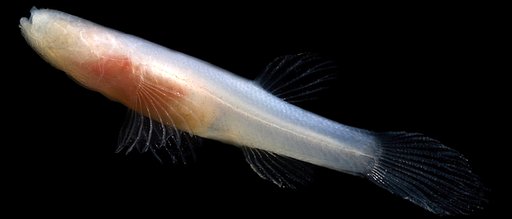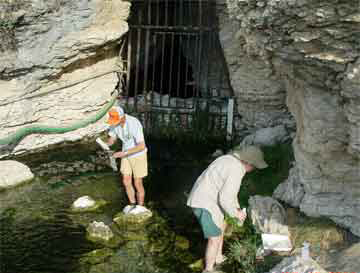
Reproduction
As one could imagine, it is quite challenging to gather accurate
documentation of the reproductive behavior in Amblyopsis
rosae. Thanks in part to the difficult nature of entering
the underground cave systems that this species is found in,
coupled with an attempt to preserve the integrity of the
aquifers, little is known about how this species goes about the
process of mate selection.  It is currently thought that when
the fish travel to Logan Cave, one of the locations where the
cavefish are found in a high concentration, that the young
reared there remain until they reach maturity (Graening et al.,
2010). The spawning
period in cavefish is thought to reach peak activity in the late
summer months of July and August, however, there is some leeway
attributed to the prior weather conditions that lead up to this
season. A critical weather event that has an influence on when
the spawning period is to occur is the spring flooding pattern.
The flooding that is very common in the
Springfield Plateau,
where the cavefish can be found, is thought to trigger a
reproductive response (Brown & Johnson, 2001). A. rosae
has a gametic life cycle, meaning the only haploid cells
found in the species are located in the gametes. Two fish
with a similar life cycle are the
red lionfish (Pterois volitans) and the
clownfish (Amphiprion ocellaris).
It is currently thought that when
the fish travel to Logan Cave, one of the locations where the
cavefish are found in a high concentration, that the young
reared there remain until they reach maturity (Graening et al.,
2010). The spawning
period in cavefish is thought to reach peak activity in the late
summer months of July and August, however, there is some leeway
attributed to the prior weather conditions that lead up to this
season. A critical weather event that has an influence on when
the spawning period is to occur is the spring flooding pattern.
The flooding that is very common in the
Springfield Plateau,
where the cavefish can be found, is thought to trigger a
reproductive response (Brown & Johnson, 2001). A. rosae
has a gametic life cycle, meaning the only haploid cells
found in the species are located in the gametes. Two fish
with a similar life cycle are the
red lionfish (Pterois volitans) and the
clownfish (Amphiprion ocellaris).
Above: Researchers conducting surveys on the water quality of Logan Cave in the Springfield Plateau. Image courtesy of the United States Fish and Wildelife Service.
Another factor that contributes to the difficulty in tracking the
reproductive patterns in A. rosae is the fact that they reproduce
very infrequently. It has been observed that with some individuals
they will reproduce in a non-annual fashion (Noltie & Wicks, 2001).
Some researchers also believe that it could be due to a lack of
resources from year to year, meaning that the cavefish do not have
enough energy to invest in reproduction (Noltie & Wicks, 2001).
A female cavefish usually only produces around 20 eggs per spawning
period,
which is very small in comparison to other fish species that can
produce hundreds to thousands of eggs at one time (Brown & Johnson,
2001). Once the eggs are
laid, the female holds them in her mouth, and then shifts them to
her gill chambers. This is done principally to
provide the young with a protective environment from other predatory
fishes and other cave organisms. The eggs remain here for a period
of four to five months until the eggs hatch (Brown & Johnson, 2001).
Initial research that was done in the early 1960’s suggested that the Ozark cavefish had an incredibly long lifespan. Those studying the elusive fish collectively believed that it was feasible for the species to reach an age of 50 years or more (Brown & Johnson, 2001). However, by monitoring the Ozark cavefish over a period of several years using small, noninvasive tracking devices, scientists now believe that A. rosea has an average lifespan of a mere four to five years, however some individuals have been known to reach an age of over ten years (Brown & Johnson, 2001) .The Ozark cavefish typically grows to a length of about 30 mm in the first year after emerging from the egg as a juvenile and reaches a total length of 55mm when it is considered to be an adult cavefish (Brown & Johnson, 2001).